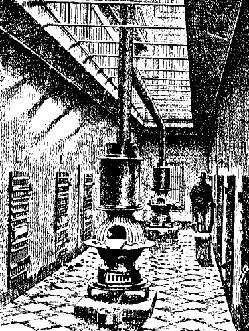
The Tombs had a Death Row
where those sentenced to be hanged
awaited their executions.
Inmates were required to exercise themselves by walking for an hour every day around the gallery of the tier on which their cells were located. They were allowed to smoke and to occupy themselves as they pleased during the day in their cells. But they were constantly kept locked in their cells, except when out for exercise. As a safeguard against fire, no lights were allowed in the cells at night.
Return to List of Tombs' Items.
The Tombs was mainly a prison for detention where persons accused of crimes were confined until trial and sentence, if any. About 50,000 prisoners were annually confined in it. As soon as they were sentenced, the convicts were sent to the institutions where they immediately started serving their terms, except those sentenced to be hanged. These remained at the Tombs for execution.
In 1902 a massive, gray building replaced the Tombs but its chateau-like appearance could not displace in common parlance the name of the original structure whose architectural style had been based on a steel engraving of an Egyptian tomb. Seven decades later that replacement was itself replaced by the present Manhattan Detention Complex but still "The Tombs" name persists.
Return to List of Tombs' Items.